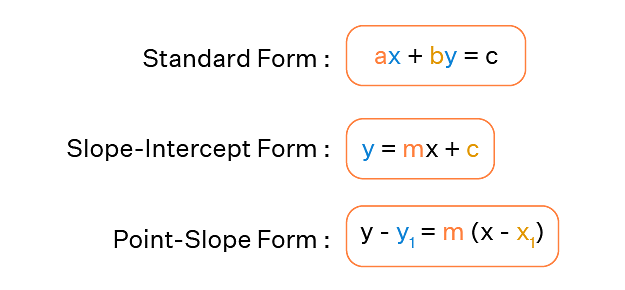If the \(XZ\)-plane divides the straight line joining the points \((2,4,7)\) and \((3,-5,8)\) in the ratio \(α:1\),then the value of \(α\) is ?
\(\dfrac{5}{4}\)
\(\dfrac{1}{3}\)
\(\dfrac{7}{8}\)
\(\dfrac{4}{5}\)
\(\dfrac{5}{2}\)
The Correct Option is D
Approach Solution - 1
Given that
Let the \(XZ \) plane divide the line segment joining points \((2,4,7) \) and \((3,−5,8)\) in the ratio \(∝:1.\)
Hence, by section formula, the coordinates of point of intersection are given by :
\((\dfrac{k(3)+2}{k+1},\dfrac{k(−5)+4}{k+1},\dfrac{k(8)+7}{k+1})\)
On the \(XZ \) plane, the \(y\)-coordinate of any point is zero.
So
,\(\dfrac{k(-5)+4}{k+1}=0\)
⇒ \(-5k+4=0\)
⇒ \(k=\dfrac{4}{5}\) (_Ans)
Approach Solution -2
We are given two points \( A(2, 4, 7) \) and \( B(3, -5, 8) \). The \( xz \)-plane divides the line segment joining these points in the ratio \( \alpha : 1 \).
The \( xz \)-plane is defined by the equation \( y = 0 \). The point \( P \) that divides the line segment \( AB \) in the ratio \( \alpha : 1 \) is given by:
\[ P \left( \frac{3\alpha + 2}{\alpha + 1}, \frac{-5\alpha + 4}{\alpha + 1}, \frac{8\alpha + 7}{\alpha + 1} \right) \]
Since \( P \) lies on the \( xz \)-plane, its \( y \)-coordinate must be zero:
\[ \frac{-5\alpha + 4}{\alpha + 1} = 0 \]
Solve for \( \alpha \):
\[ -5\alpha + 4 = 0 \]
\[ 5\alpha = 4 \]
\[ \alpha = \frac{4}{5} \]
The value of \( \alpha \) is \( \frac{4}{5} \).
The correct answer is:
(D) \( \frac{4}{5} \)
Top Questions on Straight lines
- The equation of a straight line is given by \( y = 3x + 4 \). What is the slope of the line?
- BITSAT - 2025
- Mathematics
- Straight lines
- Find the slope of the line passing through the points $ (1, 2) $ and $ (3, 6) $:
- BITSAT - 2025
- Mathematics
- Straight lines
- The equation of the line passing through the point \((1, 2)\) and perpendicular to the line \(3x + 4y - 12 = 0\) is:
- AP EAPCET - 2025
- Mathematics
- Straight lines
- Find the slope of the line perpendicular to the line $ 3x + 4y - 12 = 0 $.
- AP EAPCET - 2025
- Mathematics
- Straight lines
- The vertices of a triangle are A(–1, 3), B(–2, 2) and C(3, –1). A new triangle is formed by shifting the sides of the triangle by one unit inwards. Then the equation of the side of the new triangle nearest to origin is :
- JEE Main - 2024
- Mathematics
- Straight lines
Questions Asked in KEAM exam
- If $ f(x) = \log 3 - \sin x $, $ y = f(f(x)) $, find $ y(0) $.
- KEAM - 2025
- Functions
- The inward electric flux through a closed surface is \( 6 \times 10^{-5} \) and the outward flux is \( 3 \times 10^{-5} \). Then the total charge enclosed is?
- KEAM - 2025
- Electrostatics
- The element that has the highest melting point in the 3d series is:
- KEAM - 2025
- d -and f -Block Elements
- A planet revolves around the sun with a time period 27 times that of planet B. Planet A is at \( x \) times the distance of planet B from the sun. Find the value of \( x \).
- KEAM - 2025
- Astronomy
- Find the limit: \[ \lim_{x \to 0} \frac{\sin[x]}{[x]}, \text{ where } [x] \text{ represents greatest integer function} \]
- KEAM - 2025
- Continuity
Concepts Used:
Straight lines
A straight line is a line having the shortest distance between two points.
A straight line can be represented as an equation in various forms, as show in the image below:

The following are the many forms of the equation of the line that are presented in straight line-
1. Slope – Point Form
Assume P0(x0, y0) is a fixed point on a non-vertical line L with m as its slope. If P (x, y) is an arbitrary point on L, then the point (x, y) lies on the line with slope m through the fixed point (x0, y0) if and only if its coordinates fulfil the equation below.
y – y0 = m (x – x0)
2. Two – Point Form
Let's look at the line. L crosses between two places. P1(x1, y1) and P2(x2, y2) are general points on L, while P (x, y) is a general point on L. As a result, the three points P1, P2, and P are collinear, and it becomes
The slope of P2P = The slope of P1P2 , i.e.
\(\frac{y-y_1}{x-x_1} = \frac{y_2-y_1}{x_2-x_1}\)
Hence, the equation becomes:
y - y1 =\( \frac{y_2-y_1}{x_2-x_1} (x-x1)\)
3. Slope-Intercept Form
Assume that a line L with slope m intersects the y-axis at a distance c from the origin, and that the distance c is referred to as the line L's y-intercept. As a result, the coordinates of the spot on the y-axis where the line intersects are (0, c). As a result, the slope of the line L is m, and it passes through a fixed point (0, c). The equation of the line L thus obtained from the slope – point form is given by
y – c =m( x - 0 )
As a result, the point (x, y) on the line with slope m and y-intercept c lies on the line, if and only if
y = m x +c